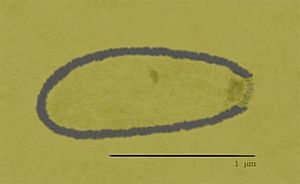Pithovirus facts for kids
Quick facts for kids Pithovirus |
|
|---|---|
 |
|
| Virus classification | |
| Group: |
Group I (dsDNA)
|
| Order: |
Megavirales
|
| Family: |
Pithoviridae
|
| Genus: |
Pithovirus
|
| Species | |
|
|
Pithovirus is a type of giant virus that infects tiny creatures called amoebae. It's a special kind of DNA virus because it has two strands of DNA, like humans do. Scientists first found Pithovirus in 2014. They discovered a living sample in ice that was 30,000 years old! This ice came from permafrost (ground that's always frozen) in Siberia, Russia.
Pithovirus is much bigger than most viruses. It's about 50% larger than the biggest viruses known before it. However, another virus called Pandoravirus has an even larger set of genetic instructions, or genome. Pithovirus itself has a thick, oval shape with an opening at one end. Inside, it looks a bit like a honeycomb.
What is the Pithovirus Genome?
The genome of Pithovirus contains 467 different genes. This is a lot for a virus, but still much less than the Pandoravirus. The genes in Pithovirus are not packed together as tightly as in other viruses. Also, about two-thirds of its proteins are different from those found in other known viruses. Even though Pithovirus looks similar to Pandoravirus, their genetic codes show they are not closely related. Pithovirus is more similar to other large DNA viruses that have a special shape called icosahedral.
How Pithovirus Reproduces
The Pithovirus genome is made of one circular, double-stranded DNA (dsDNA) chromosome. It has about 610,000 base pairs, which are the building blocks of DNA. This DNA holds the instructions for making 467 different proteins. The virus carries all the proteins it needs to make mRNA, which is like a messenger carrying instructions from DNA.
Unlike many viruses that take over the host cell's control center (the nucleus), Pithovirus does its entire reproduction cycle in the host's cytoplasm. The cytoplasm is the jelly-like substance that fills the cell.
Discovery of Pithovirus
Pithovirus sibericum was found in a sample of Siberian permafrost that was 30,000 years old. The virus was discovered buried about 30 m (98 ft) deep in very old sediment from the Pleistocene era.
Scientists found it when they took samples from a riverbank in 2000. They later exposed these samples to amoebae. The amoebae started dying, and that's how the giant viruses were found inside them. The researchers got the idea to look for new viruses in permafrost after reading about an experiment that brought a 30,000-year-old seed back to life a few years earlier.
While Pithovirus is harmless to humans, finding a virus that can still be active after being frozen for thousands of years made some people wonder. They worried that global climate change or drilling in the tundra could unearth other, possibly dangerous, ancient viruses. However, other scientists believe this is not a major threat.
See also
 In Spanish: Pithovirus para niños
In Spanish: Pithovirus para niños

